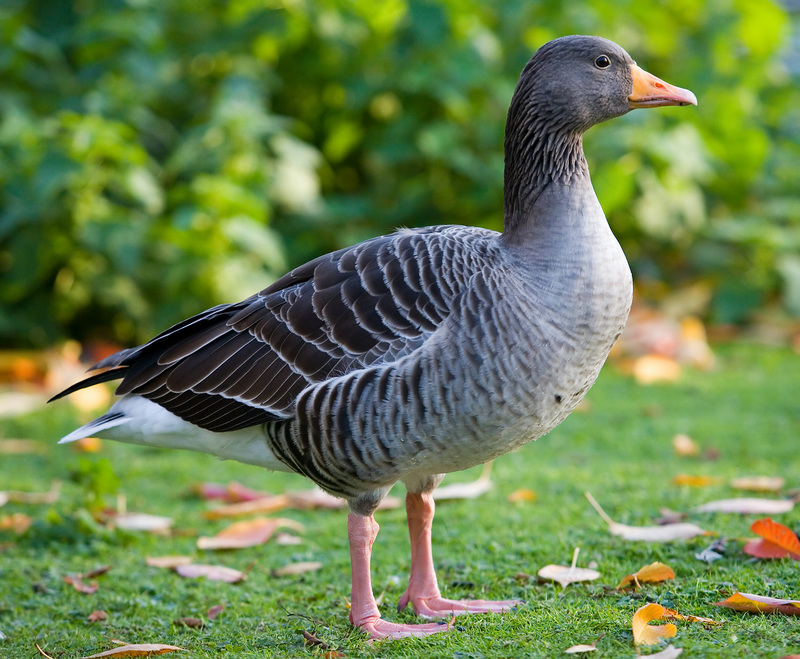ERROR : Server Busy(-1105)
ERROR : Server Busy(-1105)
Greylag Goose (Anser anser) - Wiki
Greylag Goose
From Wikipedia, the free encyclopedia
Order: Anseriformes
Family: Anatidae
[Photo] Western Greylag Goose (Anser anser anser) in St James's Park, London, England. Date 19th November, 2006. Author: Diliff (http://commons.wikimedia.org/wiki/User:Diliff). | Permission is granted to copy, distribute and/or modify this document under the terms of the GNU Free Documentation License, Version 1.2 or any later version published by the Free Software Foundation; with no Invariant Sections, no Front-Cover Texts, and no Back-Cover Texts. A copy of the license is included in the section entitled "GNU Free Documentation License". |
The Greylag Goose, Anser anser, is a bird with a wide range in the Old World. It is the type species of the genus Anser.
It was in pre-Linnean times known as the Wild Goose ("Anser ferus"). This species is the ancestor of domesticated geese in Europe and North America. Flocks of feral birds derived from domesticated birds are widespread.
The Greylag Goose is one of the species to which the Agreement on the Conservation of African-Eurasian Migratory Waterbirds (AEWA) applies.
Physical appearance
The Greylag is a large goose, 74???84 cm (29???33 in) long with a 149???168 cm (59???66 in) wingspan and a body weight of 2.3???5.5 kg (5???12 lbs). It has a large head and almost triangular bill. The legs are pink, and the bird is easily identified in flight by the pale leading edge to the wing. It has a loud cackling call, kiYAAA-ga-ga, like the domestic goose.
The western European nominate subspecies, A. a. anser, has an orange-pink bill and is slightly smaller and darker than the pink-billed Asian race, A. a. rubrirostris. Eastern European birds are often intermediate in appearance.
Interesting Behavior
These birds are famous for their extremely strong Fixed Action Patterns behavior. FAP's are highly specific, neurologically hardwired behaviors that are exhibited virtually identically everytime a stimulus is presented. These use it to push eggs back into the nest when they have fallen out. In fact, to demonstrate how ritualized these FAPs are, if the egg is removed as the graylag goose pulls it back toward the nest with its beak, the goose will continue the movement for a certain length of time and then restart the movement after it sits down on the nest and realizes an egg is still missing.
You can confront it with a novel situation, such as a doorknob next to the nest. The FAP causes it to retrieve the doorknob as if it were an egg. The exaggeration of the sign stimulus, such as replacing a goose egg with a volleyball, causes an exaggerration of the FAP.
Source: Most college level Evolution and Ecology text books. Specific source at hand (I dont want to go find my Evo/Eco books from my shelf) the Kaplan published book, "GRE EXAM Subject Test: Biology. 2007-2008 edition" on pages 214-215 in the section on "Animal Behavior and Learning", under subsection FAP.
Range and habitat
This species is found throughout the Old World, apparently breeding where suitable localities are to be found in many European countries, although it no longer breeds in southwestern Europe. Eastwards it extends across Asia to China.
The geese are migratory, moving south or west in winter, but Scottish breeders, some other populations in northwestern Europe, and feral flocks are largely resident. This species is one of the last to migrate, and it is thought that "greaylag" signifies in English "late", "last", or "slow", as in laggard, a loiterer, or old terms such as lagman, the last man, lagteeth, the posterior molar or "wisdom" teeth (as the last to appear), and lagclock, a clock that is behind time. Thus the Greylag Goose is the grey goose, which in England when the name was given, was not strongly migratory but lagged behind the other wild goose species when they left for their northern breeding quarters.
In Great Britain they much declined as a breeding bird, retreating north to breed wild only in the Outer Hebrides and the northern mainland of Scotland. However, since the 1930s and 1960s feral populations have been established elsewhere, and they have now re-colonised much of England. The breeding habitat is a variety of wetlands including marshes, lakes, and damp heather moors.
Within science, the greylag goose is most notable as being the bird with which the ethologist Konrad Lorenz first did his major studying into the behavioural phenomenon of imprinting.
North America
In North America, small populations of Greylag Geese descended from domesticated geese have become established, mostly in city parks and near humans. These geese usually exist as part of larger flocks of Canada Geese. The Greylag Goose can hybridize with the native Canada Goose, producing birds which, to say the least, can be puzzling to birders attempting to identify them.
http://en.wikipedia.org/wiki/Greylag_Goose
| The text in this page is based on the copyrighted Wikipedia article shown in above URL. It is used under the GNU Free Documentation License. You may redistribute it, verbatim or modified, providing that you comply with the terms of the GFDL. |
|

